Dietary Fish Meal Level and a Package of Choline, β-Glucan, and Nucleotides Modulate Gut Function, Microbiota, and Health in Atlantic Salmon (Salmo salar, L.)
- PMID: 36860972
- PMCID: PMC9973201
- DOI: 10.1155/2023/5422035
Dietary Fish Meal Level and a Package of Choline, β-Glucan, and Nucleotides Modulate Gut Function, Microbiota, and Health in Atlantic Salmon (Salmo salar, L.)
Abstract
Steatosis and inflammation have been common gut symptoms in Atlantic salmon fed plant rich diets. Choline has recently been identified as essential for salmon in seawater, and β-glucan and nucleotides are frequently used to prevent inflammation. The study is aimed at documenting whether increased fishmeal (FM) levels (8 levels from 0 to 40%) and supplementation (Suppl) with a mixture of choline (3.0 g/kg), β-glucan (0.5 g/kg), and nucleotides (0.5 g/kg) might reduce the symptoms. Salmon (186 g) were fed for 62 days in 16 saltwater tanks before samples were taken from 12 fish per tank for observation of biochemical, molecular, metabolome, and microbiome indicators of function and health. Steatosis but no inflammation was observed. Lipid digestibility increased and steatosis decreased with increasing FM levels and supplementation, seemingly related to choline level. Blood metabolites confirmed this picture. Genes in intestinal tissue affected by FM levels are mainly involved in metabolic and structural functions. Only a few are immune genes. The supplement reduced these FM effects. In gut digesta, increasing FM levels increased microbial richness and diversity, and changed the composition, but only for unsupplemented diets. An average choline requirement of 3.5 g/kg was indicated for Atlantic salmon at the present life stage and under the present condition.
Copyright © 2023 Åshild Krogdahl et al.
Conflict of interest statement
None of the authors of this manuscript has any conflict of interest regarding the work presented in this manuscript.
Figures



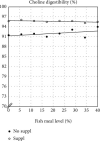
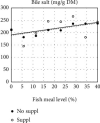



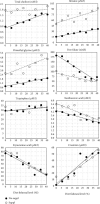


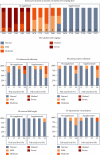

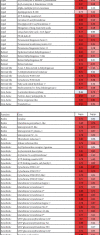
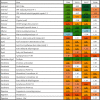



Similar articles
-
Effects of dietary lipid level and environmental temperature on lipid metabolism in the intestine and liver, and choline requirement in Atlantic salmon (Salmo salar L) parr.J Nutr Sci. 2023 May 25;12:e61. doi: 10.1017/jns.2023.45. eCollection 2023. J Nutr Sci. 2023. PMID: 37252685 Free PMC article.
-
Effects of functional ingredients on gut inflammation in Atlantic salmon (Salmo salar L).Fish Shellfish Immunol. 2023 Mar;134:108618. doi: 10.1016/j.fsi.2023.108618. Epub 2023 Feb 16. Fish Shellfish Immunol. 2023. PMID: 36801242
-
Alternative Protein Sources in the Diet Modulate Microbiota and Functionality in the Distal Intestine of Atlantic Salmon (Salmo salar).Appl Environ Microbiol. 2017 Feb 15;83(5):e02615-16. doi: 10.1128/AEM.02615-16. Print 2017 Mar 1. Appl Environ Microbiol. 2017. PMID: 27986728 Free PMC article.
-
Effects of Fishmeal Substitution with Mealworm Meals (Tenebrio molitor and Alphitobius diaperinus) on the Growth, Physiobiochemical Response, Digesta Microbiome, and Immune Genes Expression of Atlantic Salmon (Salmo salar).Aquac Nutr. 2024 Jan 6;2024:6618117. doi: 10.1155/2024/6618117. eCollection 2024. Aquac Nutr. 2024. PMID: 38221936 Free PMC article.
-
Effect of yeast species and processing on intestinal microbiota of Atlantic salmon (Salmo salar) fed soybean meal-based diets in seawater.Anim Microbiome. 2023 Apr 4;5(1):21. doi: 10.1186/s42523-023-00242-y. Anim Microbiome. 2023. PMID: 37016467 Free PMC article.
Cited by
-
Effects of Algal-Derived β-Glucan on the Growth Performance, Intestinal Health, and Aeromonas veronii Resistance of Ricefield Eel (Monopterus albus).Aquac Nutr. 2025 Jan 21;2025:8172810. doi: 10.1155/anu/8172810. eCollection 2025. Aquac Nutr. 2025. PMID: 39877687 Free PMC article.
-
Effects of dietary lipid level and environmental temperature on lipid metabolism in the intestine and liver, and choline requirement in Atlantic salmon (Salmo salar L) parr.J Nutr Sci. 2023 May 25;12:e61. doi: 10.1017/jns.2023.45. eCollection 2023. J Nutr Sci. 2023. PMID: 37252685 Free PMC article.
-
Effects of dietary fish to rapeseed oil ratio on steatosis symptoms in Atlantic salmon (Salmo salar L) of different sizes.Sci Rep. 2024 Aug 3;14(1):18006. doi: 10.1038/s41598-024-68434-3. Sci Rep. 2024. PMID: 39097615 Free PMC article.
-
Longitudinal study on the effects of a synbiotic supplement to Atlantic salmon diets on performance, gut microbiota and immune responses during antibiotic treatment and subsequent recovery.Anim Microbiome. 2024 Dec 20;6(1):71. doi: 10.1186/s42523-024-00360-1. Anim Microbiome. 2024. PMID: 39707555 Free PMC article.
-
Brewers' Yeast (Saccharomyces cerevisiae) Purified Functional Feed Additives Mitigate Soybean Meal-Induced Enteritis in Atlantic Salmon (Salmo salar) Parr.Aquac Nutr. 2025 Apr 10;2025:8555658. doi: 10.1155/anu/8555658. eCollection 2025. Aquac Nutr. 2025. PMID: 40255579 Free PMC article.
References
-
- Penn M. H. Annual Report on Fish Health . Norwegian Institute of Veterinary Medicine; 2011. Lipid malabsorption in Atlantic Salmon – the recurring problem of floating feces.
-
- NRC. NRC Nutrient Requirement of Fish and Shrimp . National Academic Press; 2011. Vitamins; pp. 186–220.
-
- Krogdahl A., Hansen A. K. G., Kortner T. M., et al. Choline and phosphatidylcholine, but not methionine, cysteine, taurine and taurocholate, eliminate excessive gut mucosal lipid accumulation in Atlantic salmon (Salmo salar L) Aquaculture . 2020;528:p. 735552. doi: 10.1016/j.aquaculture.2020.735552. - DOI
LinkOut - more resources
Full Text Sources
